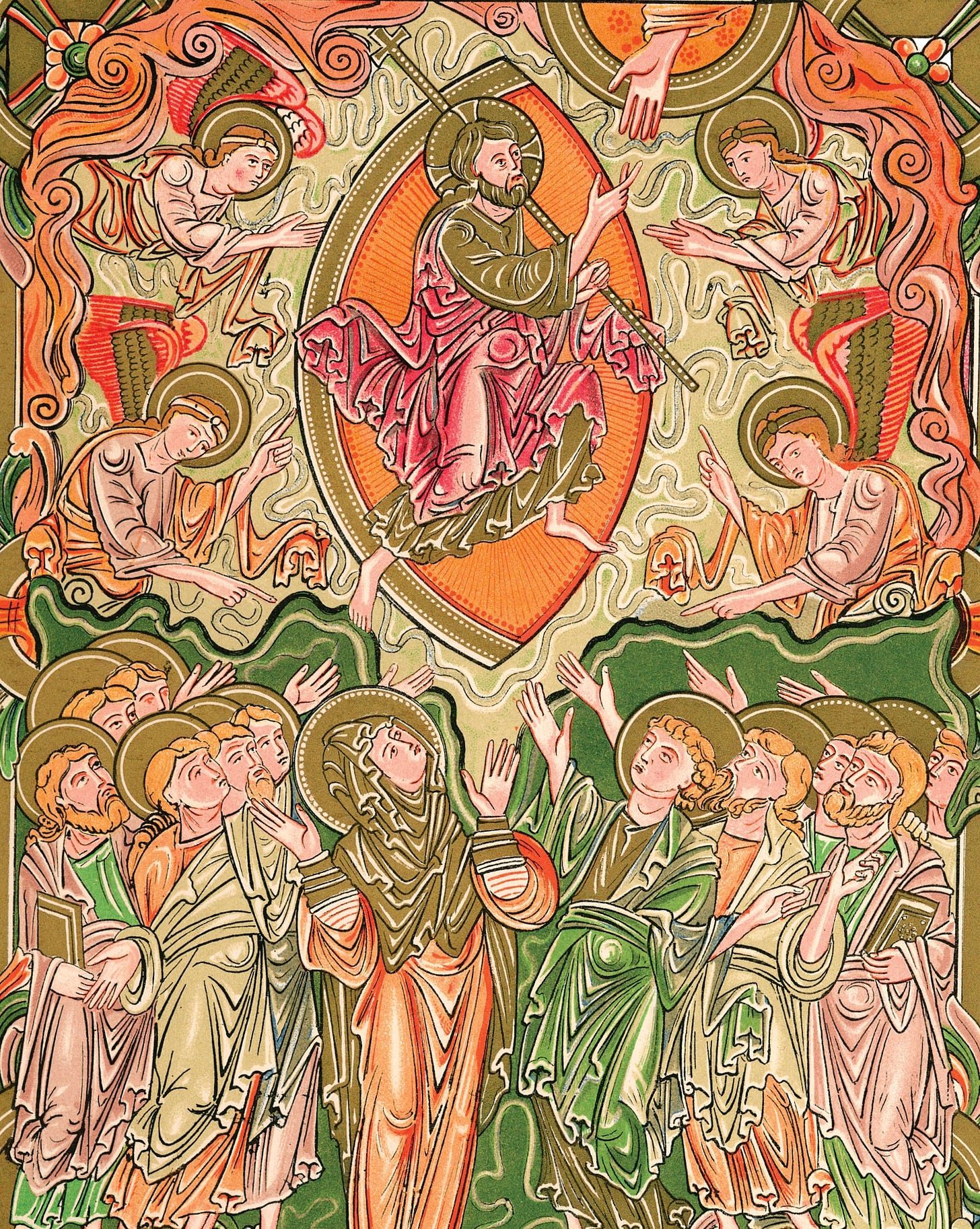I often start teaching on the Ascension with the word SAMTSIRHC. No, it is not some obscure bit of Hebrew: it is simply CHRISTMAS backwards. And that is the basic meaning of the Ascension. Christ descended among us at the Annunciation and was born among us at Christmas; at the Ascension, He returns to the Father. In the topsy-turvy logic of heaven, what goes down, must come up.
For the disciples at the time, this was a bittersweet revelation. They had know their Lord descended as a man with whom they ate and drank and laughed and worshipped. Then, after His Resurrection, they had known Him as something else, still appearing to them, but transformed. Now, they stood gazing up forlornly as the cloud enveloped Him from their sight. Was this it? Would they see Him no more?
And that is how we feel about all those whom we love and see no more in this world, when we look up into the obscure clouds from here below and ask ourselves, is there really anything more out there? We too feel left behind. We fear that we will never meet again.
But this is precisely where we need to be enveloped by that topsy-turvy logic of heaven manifested at the Ascension. For when Our Lord ascends to heaven, He takes us with Him. Not just those who have died, but us who are left behind, too. He has lifted up our humanity to the place where it was always meant to be, ruling above the angels. This was always the plan: and this is why the Devil fell, of pride and envy that he should be subject to a thing of mere flesh. Yet the Lord’s plan persisted despite the Enemy’s wiles. The promise made to Abraham, that his offspring would be as the stars, is made good at the Ascension. Those whom Our Lord descended to uplift, going even as deep as Hades, are assured of their place among the brightest lights of Heaven.
We do not need to wait for death to know that Heaven. By being literally “incorporated” into Christ, that is, made members or limbs of His Body, we take Him as our Head, and we learn to see through His eyes. Instead of thinking about heaven from the cramped vantage point of flesh and dust that we inhabit here below, our spiritual senses grow so that we can start to see that flesh and dust below, all the earthy matter of creation, through heavenly eyes, divine eyes, the eyes of eternity. We come to see the universe in a grain of sand or an acorn. We see that this world is the passing shadow of the higher reality which has no beginning or end.
Our short lives — even the shortest lives of those we love who died too young — are not even a fraction of the eternal life which we will enjoy together and those who have died in Christ enjoy even now. It may be hard for us to see through the cloud of grief and loss, but those who have gone before us are with us still: not in a cloud of grey grief, but in the radiant cloud of witnesses, a darkness so dazzling, or light so blinding, that we below must shield our eyes from its glare.
How do we come by this incorporation into Christ, and begin to see with the eyes of the Risen and Ascended One? Why, through baptism into His Body, death to the world, flesh and Devil; through frequent reception of His Body and His Blood, that we may dwell in Him and He in us, nourishing us for the fight; through meditation on His Holy Word in Scripture, the sword of Truth; through fasting, prayer and almsgiving; in short, through the corporate life He has given us, by the gift of His Spirit, in Holy Church.
Our Lord has broken the barrier between heaven and earth. He has rent the veil. He leaves us only to take His hand and cross the threshold. That is where our worship leads us: through the Nave, the great ship of the Church, stepping up into the Chancel, and looking to where the Altar stands, higher still, surrounded in the haze of incense, shielding the Holy of Holies from our sight. And it is down that mountain that Our Lord emerges, today, to meet us in bread and wine: not to leave us here, but to be with us always, drawing us up away from the things of this world to the unseen and eternal beauties that await above. Let our hearts rest there, where true treasure can be found.
So come, worship the Ascended One, become one with Him in the Spirit, and be lifted up, at this great Feast of the Church, that we may be one, as He is One, with the Father.






Thank you for this.
Biblically, we have seen repetition of the theme of the descent of Heaven to Earth, and the overlap of the two. We see it in Eden, we see it in the Tabernacle, we see it in Zion and the Temple - God coming to Earth to dwell with His people. All these faded though, as they only pointed forward to the ultimate reality of the incarnation.
The incarnation is the last and truest establishment of the heaven and earth overlap. God takes on flesh and walks among us, and ascends back into the heavens. He incorporates us into His body through baptism, and we participate in the New Creation here and now as God’s dwelling place on earth with His people. Together we anticipate the unveiling of the heavenly Jerusalem where we will behold our God face to face again
Beautiful. Thank you.